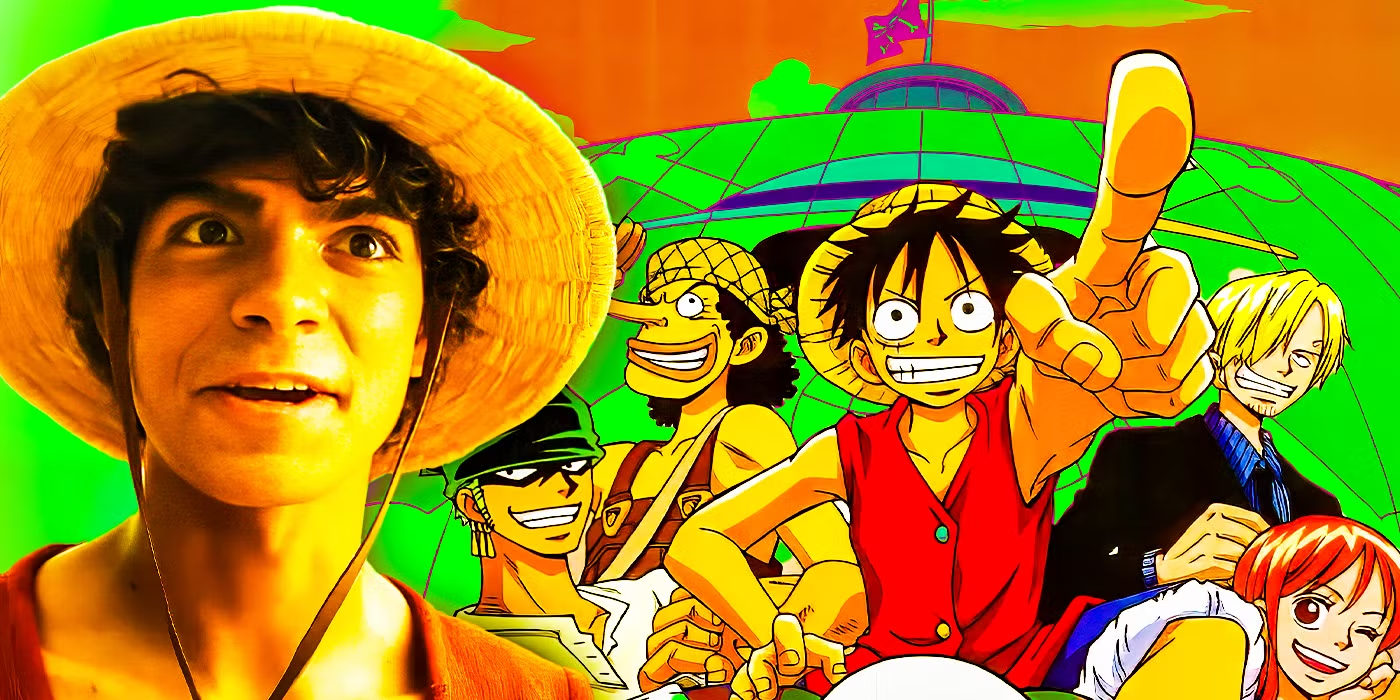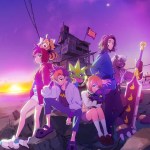The One Piece live-action series on Netflix is packed with Easter eggs that will delight long-time fans of the anime and manga. From subtle foreshadowing, such as Kuro’s attack on Luffy in Episode 4 mirroring Luffy’s iconic post-time-skip scar, to Sanji’s mention of the Bluefin Elephant Tuna from Loguetown, the creators have made sure to include plenty of nods for dedicated fans. Other references, like Zoro’s notoriously bad sense of direction and the Revolutionary Army’s newspaper cameo in Episode 8, further enhance the experience for those familiar with the original storylines. These hidden gems not only pay homage to the source material but also hint at future arcs, such as the possible introduction of Loguetown and the significant role of Jinbe in upcoming seasons.
For those exploring the live-action series for the first time, these Easter eggs offer an additional layer of excitement and depth. Whether it’s the appearance of Kong in the credits, the design of Luffy’s Jolly Roger, or the inclusion of the iconic We Are! theme song, these details help connect the live-action adaptation to its anime roots. With such intricate world-building, the One Piece series on Netflix ensures that both casual viewers and hardcore fans can find something to love. Visit animeking for more insights and updates about the live-action One Piece title and other anime adaptations.
Read More :- Top 9 Live Action Anime Adaptations That Are ACTUALLY GOOD
13. Kuro Cutting Luffy: A Foreshadowing of Luffy’s Time-Skip Scar

In Episode 4 of Netflix’s One Piece live-action series, Luffy’s clash with Kuro offers a subtle but powerful Easter egg for long-time fans. During their battle, Kuro’s attack mirrors the exact spot where Luffy will later get his iconic scar in the post-time skip arc. This foreshadowing detail not only stays true to the original anime and manga but also symbolizes Luffy’s future growth, making it a thrilling moment for dedicated viewers.
This nod to Luffy’s chest scar is just one of many intricate details packed into the live-action series. By referencing key moments from the anime and manga, the series rewards fans with hidden gems that enhance the overall experience. For more details and insights on the One Piece live-action title.
12. Luffy’s First Jolly Roger: A Familiar Design

In the live-action adaptation of One Piece, Luffy’s first attempt at creating the Straw Hat Pirates’ Jolly Roger stays true to the original design seen in both the manga and anime. While the show makes some changes to the story, this detail remains accurate, capturing Luffy’s creative but childlike drawing skills. The Jolly Roger represents the spirit of the crew, and seeing it faithfully recreated is a treat for longtime fans.
In the anime, Luffy designs the Jolly Roger after meeting Usopp, but the live-action version has him create it earlier. Despite this shift in the timeline, the design itself stays consistent, preserving the sense of nostalgia and connection to the original material. This small but significant detail shows the creators’ dedication to honoring the source.
11. Sanji Mentions Loguetown’s Bluefin Elephant Tuna

In Episode 5 of the One Piece live-action, Sanji mentions the Bluefin Elephant Tuna, an exotic and rare fish he encountered in Loguetown. This fish, popular among fans for its extravagant nature, is a unique part of the story’s world-building. The mention of Loguetown not only deepens the lore but also teases the potential appearance of this iconic location in the next season.
This reference to Loguetown in the live-action series hints at exciting developments to come in season 2, laying the groundwork for more epic adventures for the Straw Hat Pirates. Fans can anticipate more world-building and iconic moments from the original manga and anime in future episodes.
10. Kong’s Cameo in the Credits’ Map

The ending credits of the One Piece live-action aren’t just for show; they contain hidden gems, including a reference to Kong, the World Government’s Commander in Chief. Kong is a major figure in the One Piece universe, having previously served as the Marine’s Fleet Admiral before transitioning to his current role. His mention in the credits hints at deeper political intrigue and future plot developments.
This subtle reference to Kong lays the groundwork for more intense storylines in upcoming seasons, possibly introducing viewers to the complex world of the World Government. Fans of the manga and anime will recognize the significance, as Kong’s role in the larger power dynamics of the world is crucial to the series’ expanding political landscape.
9. Episode Title Cards: A Love Letter to the Characters

Each episode of the One Piece live-action adaptation features uniquely crafted title cards, with designs that reference key characters from the series. Episode 1’s card, for instance, is inspired by Luffy, while Episode 2 gives a nod to Buggy. These creative touches bring familiar elements from the anime and manga to life, enhancing the visual storytelling.
The title cards also highlight smaller, iconic traits, such as Usopp’s long nose and Sanji’s heart-shaped eyes, which fans will instantly recognize. This attention to detail demonstrates the show’s dedication to honoring the source material, creating an engaging experience for both longtime fans and new viewers.
8. Noland and Jaya Island: Legends and Gold

In One Piece Episode 6, the mention of Mont Blanc Noland brings a legendary explorer into the spotlight, known for his travels to the Grand Line and the discovery of Jaya, the island famed for its city of gold. This reference not only enriches the series’ lore but also sets the stage for future arcs filled with treasure hunts and historical mysteries.
Noland’s story first emerged in Chapter #286 of the manga, providing a delightful nod for manga readers who recognize its significance. By weaving Noland’s tale into the live-action adaptation, the series deepens its narrative complexity and prepares viewers for the adventures that lie ahead in the search for hidden treasures.
7. Zoro’s Sense of Direction is On Point—Sort Of

Zoro’s infamous lack of navigation skills is hilariously portrayed in the One Piece live-action adaptation, particularly in Episode 4. When Luffy asks Zoro how he found him, Zoro candidly admits he wasn’t looking for Luffy at all; he was just lost. This moment aligns perfectly with his manga counterpart, who is renowned for having the world’s worst sense of direction.
Fans of Zoro will appreciate how this small yet essential character trait has been preserved in the live-action series. By highlighting Zoro’s navigational struggles, the adaptation stays true to the spirit of the original story, adding depth and humor to his character while keeping long-time fans entertained.
6. Jinbe’s Influence Lingers

In Episode 7 of the One Piece live-action adaptation, a conversation between Arlong and Nezumi hints at the presence of one of the Seven Warlords of the Sea being a fish-man, which is a clear nod to Jinbe. Although Jinbe doesn’t make an appearance in season 1, this mention builds anticipation for his eventual introduction into the series.
Fans who are familiar with Jinbe’s deep connection to the Straw Hat Pirates will find this reference particularly exciting. It not only enriches the storyline but also lays the groundwork for future character developments, hinting at the expanded narrative that awaits in subsequent seasons.
5. Fishman Karate and the Water Bullet Technique

While the underwater battles were omitted from the One Piece live-action adaptation, fans were still delighted by authentic Fishman Karate moves showcased throughout the series. In Episode 7, Kuroobi faces off against Buggy and Sanji, employing the Water Bullet technique, which is a signature fighting style from the Arlong Park arc.
This brief yet thrilling inclusion demonstrates the creators’ commitment to preserving the original fight dynamics from the source material. By incorporating such iconic techniques, the adaptation honors the essence of the characters and their abilities, keeping long-time fans engaged and excited for the action to come.
4. Island of Rare Animals Spotted in the Credits

Another intriguing detail from the credits of the One Piece live-action adaptation is the mention of the Island of Rare Animals, which did not appear in the first season. This island, famous for its unique and bizarre creatures, serves as a crucial stop for the Straw Hat crew in both the anime and manga.
The inclusion of the Island of Rare Animals in the credits hints that it may play a significant role in future episodes. This reference not only excites fans familiar with the original story but also suggests that the live-action series will continue to explore the rich and diverse world of One Piece as it progresses.
3. Momoo the Sea Cow Lurking on the Map

While Momoo, the giant sea cow known for harassing the Straw Hat Pirates, didn’t appear in the main narrative of Season 1 of the One Piece live-action adaptation, sharp-eyed fans will spot him on the map during the closing credits. This subtle inclusion serves as a delightful nod to one of the more whimsical characters from the anime, blending elements of humor and danger.
By featuring Momoo in the credits, the creators show their commitment to honoring the quirky charm of the original series. This small detail not only brings a smile to long-time fans but also hints at the potential for more lighthearted yet perilous encounters in future episodes.
2. “We Are!” Lives On

The iconic song “We Are!”, from the original anime intro, makes a nostalgic return in the One Piece live-action adaptation, appearing twice throughout the series. The first instance occurs in Episode 4 when the Straw Hats depart Syrup Village, creating a sense of adventure and excitement. It also plays during the finale after the memorable barrel scene, enhancing the emotional weight of the moment.
This inclusion of the beloved theme song tightly connects the live-action series to its anime roots, offering long-time fans a heartwarming reminder of their journey with the Straw Hat Pirates. By weaving this classic track into the score, the creators effectively bridge the gap between the two mediums, enriching the viewing experience for audiences familiar with the original story.
1. The Revolutionary Army’s Newspaper Cameo

In Episode 8 of the One Piece live-action adaptation, a significant detail occurs when Kaya is seen looking at Luffy’s Wanted Poster, accompanied by a newspaper featuring a headline about the Revolutionary Army. First introduced in Chapter #100 of the manga, the Revolutionary Army is crucial to the overarching narrative of the One Piece universe. This subtle inclusion hints that the live-action series is already laying the groundwork for future storylines.
The reference to the Revolutionary Army suggests that the creators are planning ahead, potentially setting the stage for the introduction of new political players and exciting plot developments. By incorporating such meaningful elements from the original manga, the adaptation keeps fans engaged while building anticipation for the adventures to come in subsequent seasons.
Read More :- Top 15 Anime That Caused MAJOR OUTRAGE
Conclusion
The One Piece live-action series on Netflix is a treasure trove of Easter eggs and references that both anime and manga fans will love. From foreshadowing Luffy’s iconic scar to nods like Sanji mentioning Loguetown’s Bluefin Elephant Tuna and Zoro’s comical sense of direction, the series stays true to its roots while hinting at future arcs. These hidden details add depth to the show, rewarding long-time fans while keeping new viewers engaged. For more insights and exciting updates on the One Piece live-action title, check out the animeking.










